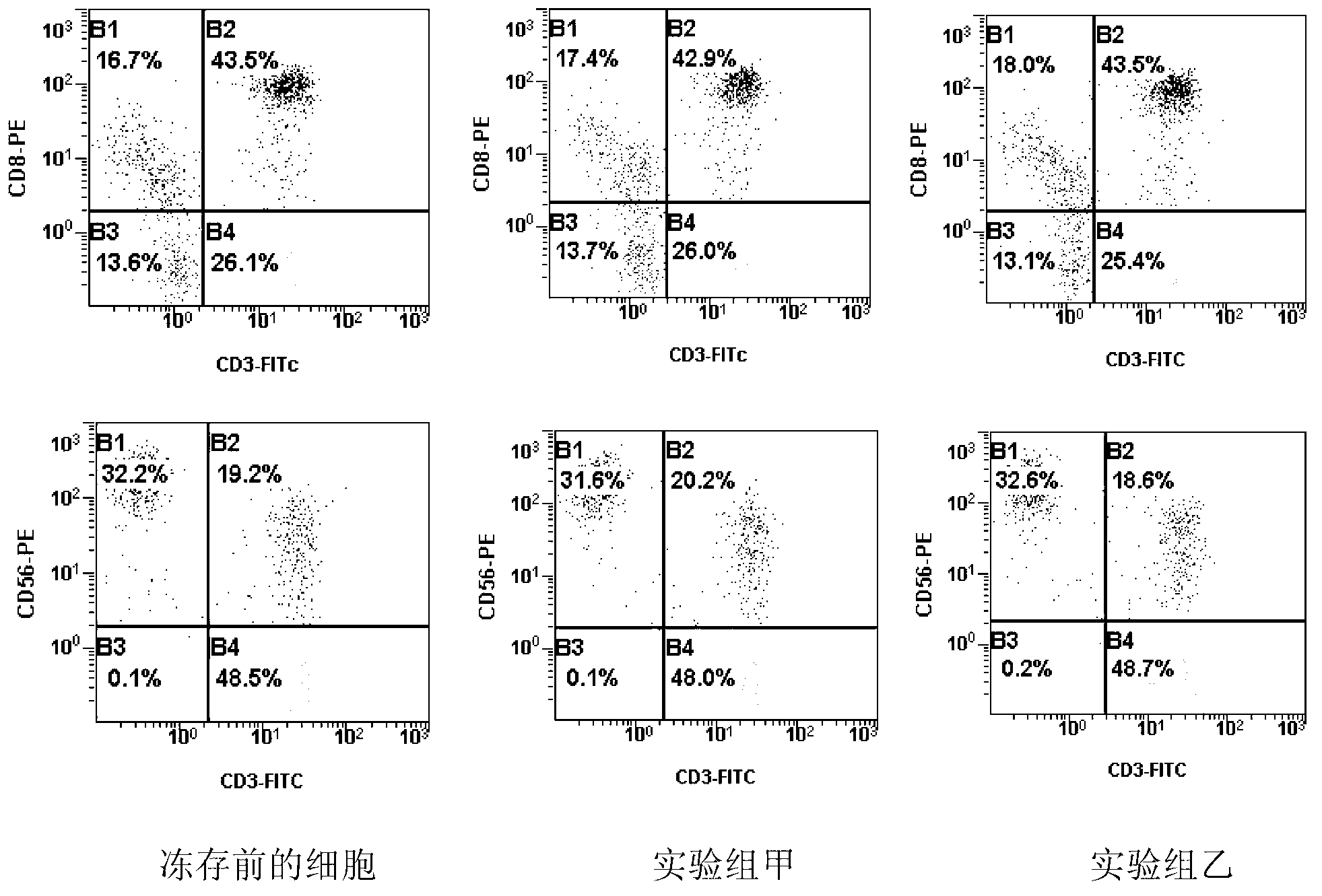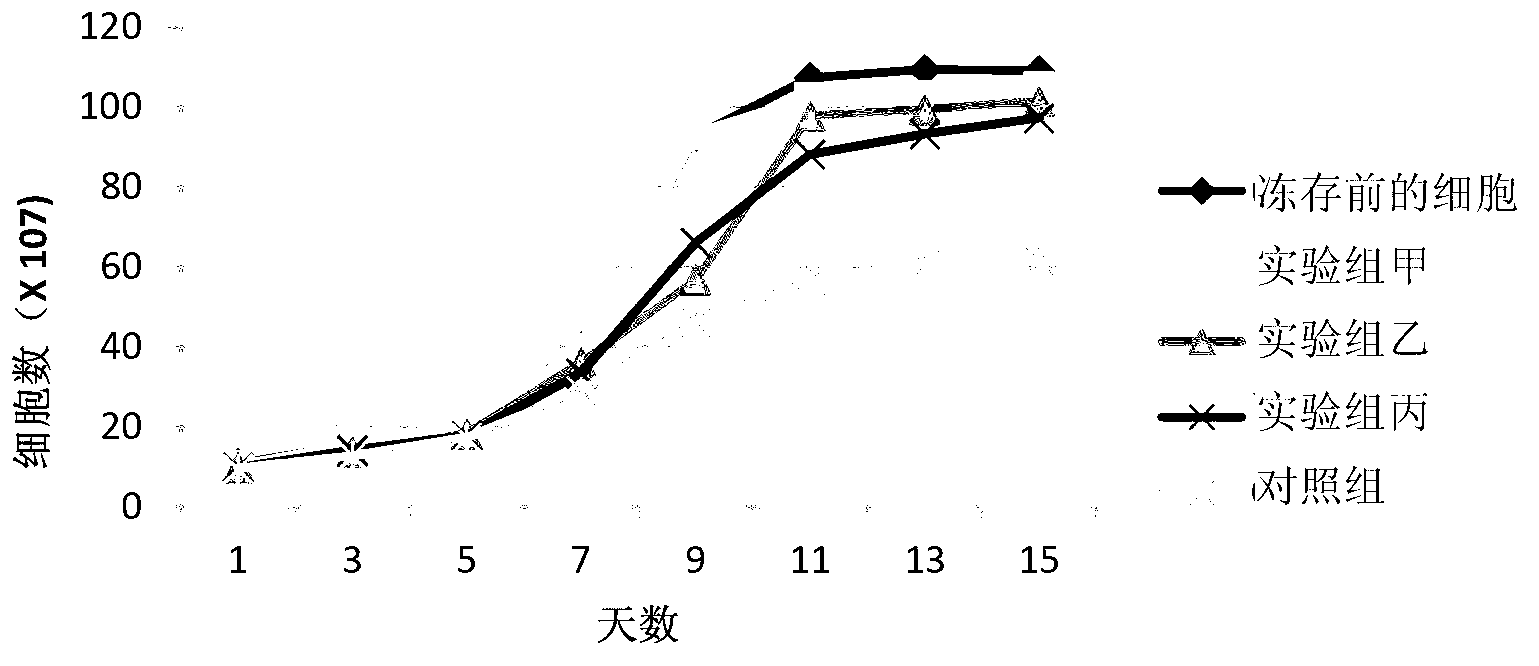Cryopreservation solution for preserving congenital intrathoracic kidney (CIK) cells and application thereof
A cryopreservation solution and cell suspension technology, applied in the field of cryopreservation solution, can solve the problems of unfavorable clinical application, long CIK cell culture cycle, easy contamination, etc., to expand blood volume, reduce the formation of ice crystals, and reduce cell swelling. Effect
- Summary
- Abstract
- Description
- Claims
- Application Information
AI Technical Summary
Problems solved by technology
Method used
Image
Examples
Embodiment 1
[0026] Embodiment 1, the preparation of cell cryopreservation liquid
[0027] The preparation method of cell freezing liquid A: add dimethyl sulfoxide and dextran to the GT-T551 cell culture medium, so that the concentration of dimethyl sulfoxide is 10% (volume ratio), and the concentration of dextran 10% (volume ratio).
[0028] The preparation method of cell cryopreservation solution B: add dimethyl sulfoxide and dextran to the GT-T551 cell culture medium, so that the concentration of dimethyl sulfoxide is 5% (volume ratio), and the concentration of dextran 15% (volume ratio).
[0029] The preparation method of cell cryopreservation solution C: add dimethyl sulfoxide and dextran to GT-T551 cell culture medium, so that the concentration of dimethyl sulfoxide is 15% (volume ratio), so that the concentration of dextran 5% (volume ratio).
[0030] Cell cryopreservation solution D (traditional cell cryopreservation solution): add dimethyl sulfoxide and human serum albumin to G...
Embodiment 2
[0031] Embodiment 2, the acquisition and cryopreservation of CIK cells
[0032] 1. Acquisition of CIK cells
[0033] Umbilical cord blood: Obtained from full-term healthy fetuses of Xinxiang Medical College, with the consent of the family members.
[0034] 1. Use Ficoll lymphocyte separation medium (density gradient centrifugation) to separate mononuclear cells from cord blood.
[0035] 2. Put the mononuclear cells obtained in step 1 in 100ml of GT-T551 cell culture medium containing 1000μg / ml IFN-γ and 1% (volume ratio) autologous plasma (that is, umbilical cord blood plasma used to separate nuclear cells) at 37°C Let stand for 24 hours.
[0036] 3. Add CD3 monoclonal antibody and cytokine IL-2 to the culture system completed in step 2, so that the concentration of CD3 monoclonal antibody is 75ng / ml, and the concentration of cytokine IL-2 is 1000U / ml, and culture at 37°C for 24 Hour.
[0037] 4. Add 300ml of GT-T551 cell culture medium containing 1000U / ml cytokine IL-2 to...
Embodiment 3
[0071] Embodiment 3, acquisition and cryopreservation of CIK cells
[0072] The CIK cells used in this example were purchased from Shanghai Baili Biological Serum Network.
[0073] 1. Cryopreservation of CIK cells
[0074] Same as step 2 of embodiment 2.
[0075] 2. Recovery of CIK cells
[0076] 1. Same as step 3 of embodiment 2.
[0077] 2. Inoculate the CIK cells obtained in step 1 into GT-T551 cell culture medium containing 1000U / ml cytokine IL-2 and 1% (volume ratio) human plasma, and culture at 37°C.
[0078] 3. Morphological observation
[0079] 1. In step 2 of 2, start timing from inoculation of CIK cells, and collect CIK cells (that is, cells after thawing) 24 hours later.
[0080] 2. Observe the CIK cells before cryopreservation and the recovered cells under an inverted microscope, see Figure 5 .
[0081] Figure 5 Among them, D is the cells before cryopreservation, E is the cells of the experimental group A after recovery, and F is the cells of the control ...
PUM
 Login to View More
Login to View More Abstract
Description
Claims
Application Information
 Login to View More
Login to View More - R&D
- Intellectual Property
- Life Sciences
- Materials
- Tech Scout
- Unparalleled Data Quality
- Higher Quality Content
- 60% Fewer Hallucinations
Browse by: Latest US Patents, China's latest patents, Technical Efficacy Thesaurus, Application Domain, Technology Topic, Popular Technical Reports.
© 2025 PatSnap. All rights reserved.Legal|Privacy policy|Modern Slavery Act Transparency Statement|Sitemap|About US| Contact US: help@patsnap.com



